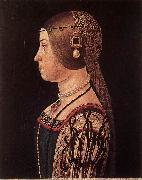Wholesale Oil Painting No Minimum |
|||||||||||
|
|
|||||||||||

|
|||||||||||
|
|
|
||||||||
ARALDI, AlessandroItalian Painter, ca.1460-1530 He apparently assisted with contemporary Cristoforo Caselli (il Temperello). His work shows the influences of early Venetian Renaissance painters such as Giovanni Bellini and Vivarini, but also Lorenzo Costa from Ferrara. He painted frescoes in the Benedictine monastery of San Paolo. He also painted two scenes with the story of St. Catherine, the Dispute before the emperor Maximilian and St. Catherine and St. Jerome, including an odd Annunciation (1514), for the abbess Giovanna da Piacenza (1514). Antonio Allegri (Correggio) would complete his own masterpiece frescoes for the abbess in a strikingly different, and for the age, more modern, style. |
||||||||
|
|
||||||||
Portrait of Barbara Pallavicino
Portrait of Barbara Pallavicino Painting ID:: 4836 |
1510s
Oil on wood, 46,5 x 35 cm
Galleria degli Uffizi, Florence
1510s Oil on wood, 46,5 x 35 cm Galleria degli Uffizi, Florence |
|||||||
|
|
||||||||
|
ALLORI Alessandro Italian Mannerist Painter, 1535-1607 Born in Florence. After the death of his father in 1540 he was brought up and trained in art by a close friend, often referred to as his 'uncle', the mannerist painter Agnolo Bronzino, whose name he sometimes assumed in his pictures. In some ways, Allori is the last of the line of prominent Florentine painters, of generally undiluted Tuscan artistic heritage: Andrea del Sarto worked with Fra Bartolomeo (as well as Leonardo Da Vinci), Pontormo briefly worked under Andrea, and trained Bronzino, who trained Allori. Subsequent generations in the city would be strongly influenced by the tide of Baroque styles pre-eminent in other parts of Italy. Freedburg derides Allori as derivative, claiming he illustrates "the ideal of Maniera by which art (and style) are generated out of pre-existing art." The polish of figures has an unnatural marble-like form as if he aimed for cold statuary. It can be said of late phase mannerist painting in Florence, that the city that had early breathed life into statuary with the works of masters like Donatello and Michelangelo, was still so awed by them that it petrified the poses of figures in painting. While by 1600 the Baroque elsewhere was beginning to give life to painted figures, Florence was painting two-dimensional statues. Furthermore, in general, with the exception of the Contra Maniera artists, it dared not stray from high themes or stray into high emotion. Portrait of Barbara Pallavicino mk67 Oil on panel 18 5/16x13 3/4in Uffizi,Gallery. |
||||||||
|
|
||||||||
|
Prev Next
|
||||||||
|
|
||||||||
|
Related Paintings to ALLORI Alessandro :. |
||||||||
|
|
||||||||
|
CONTACT US |

